Day 3 of a 3 day long weekend of Autumn Migration Tours today. We had some sunny intervals today but isolated showers were coming in off the North Sea from time to time on the NE wind. Thankfully, they missed us in the morning and we managed to dodge them in the afternoon.
The morning was spent exploring Cley. We parked at the visitor centre and walked out towards the main hides. Looking out towards the sea, we could see a couple of lines of Brent Geese flying in, presumably migrants arriving from Russia for the winter. Along the Skirts path, a male Stonechat flew ahead of us, perching on the brambles and fence posts, before flying out into the field. A Meadow Pipit perched up in the morning sun on a dead thistle. A Kestrel circled up overhead, and was chased off by another couple of Meadow Pipits.
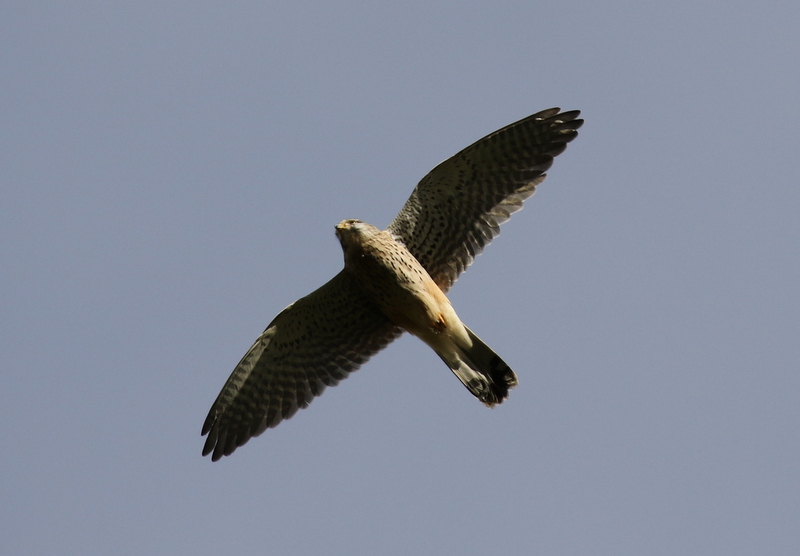 Kestrel – circled overhead, pursued by a Meadow Pipit
Kestrel – circled overhead, pursued by a Meadow Pipit
As we walked out along the boardwalk, we flushed a noisy flock of House Sparrows from the bushes in the reeds. A young Marsh Harrier was quartering over the reeds and seemed to delight in flushing all the birds from the scrapes as it flew over.
There were lots of small waders in front of Teal Hide visible from the visitor centre earlier, but by the time we got out there they seemed at first to have disappeared, presumably unnerved by the Marsh Harrier. We found them again as they emerged from behind the large island, 30 Dunlin. Then a Ruff appeared from the same place as the Dunlin. It was a juvenile, with buffy underparts. It was followed shortly after by a winter adult Ruff, whiter below and paler grey-brown above, and with orange legs. It was good to see the two Ruff next to the Dunlin for size comparison.
A Black-tailed Godwit was feeding just in front of the hide, but a larger flock were sleeping over towards Bishop Hide, all in a line, all on one leg with heads tucked in. They are mostly in winter plumage now, dull grey. A single Avocet stood at the end of the line. Further over, we picked up a couple of Swallows hawking for insects over the reeds. They eventually made their way past, followed by a few more – migrants, on their way south down to Africa for the winter, pausing briefly to refuel on their journey.
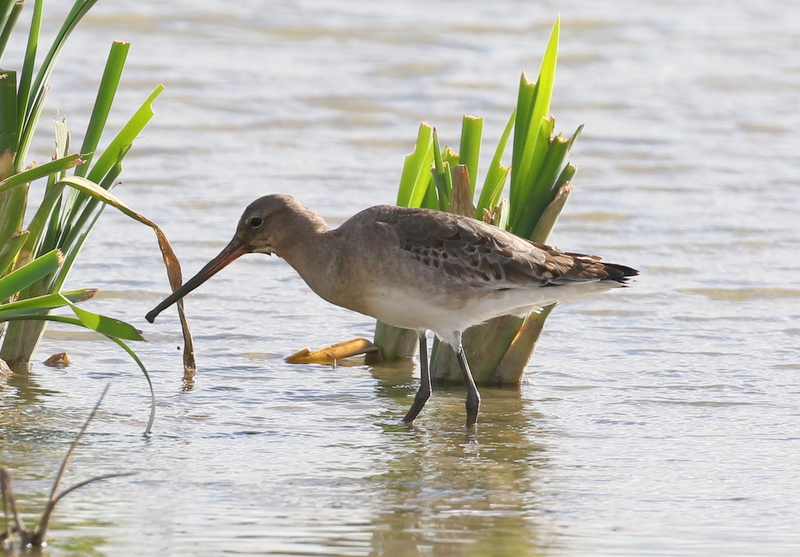 Black-tailed Godwit – this one was feeding in front of Teal Hide
Black-tailed Godwit – this one was feeding in front of Teal Hide
Simmond’s Scrape has just been ‘reprofiled’. The digger has gone, but the scrape itself will presumably take a while to settle back down. Still, from Dauke’s Hide we could see lots of ducks, all still mostly in duller eclipse plumage – Wigeon, Teal and Shoveler. A single Grey Plover and a single Golden Plover were on the bare island over at the back – a nice opportunity to compare them side by side. Several Meadow Pipits and Pied Wagtails were still enjoying the bare muddy margins of the scrape.
Some of the flocks of Brent Geese we had seen arriving earlier had landed in Eye Field. Looking out from the hide in that direction, we could see more Brents landing with a large gaggle of Canada Geese. On the front edge of the flock, out on the grass, we could see some ‘grey’ geese and through the scope we confirmed our suspicions – they were White-fronted Geese. Small numbers come to Norfolk from Russia for the winter, normally to the Broads or Holkham, so these birds had probably stopped off briefly to get something to eat and have a rest after a long journey from the continent.
 White-fronted Geese – we could see nine in with the Canadas and Brent Geese
White-fronted Geese – we could see nine in with the Canadas and Brent Geese
Looking more carefully, we could count nine White-fronted Geese. Several had sat down in the grass to sleep. On the ones that were awake and feeding, we could see their pink bills with white band round the base, and the distinctive black belly bars.
After making our way back to the visitor centre, we drove on to the car park at the end of the East Bank. Up to four Jack Snipe had been reported just across the road on Snipe’s Marsh (for once, appropriately named!!), so we walked over to see if we could see them. Thankfully there were a couple of people there who told us where two of them were, because the Jack Snipe had gone to sleep in the edge of the reeds and were very well camouflaged.
 Jack Snipe – with bright golden yellow mantle stripes and dark central crown
Jack Snipe – with bright golden yellow mantle stripes and dark central crown
We watched the Jack Snipe for a few minutes and one of them then woke up and started feeding. As it did so, we could see the distinctive bobbing action, bouncing up and down as it walked slowly along, probing its bill into the mud. Nearby, we could see at least five Common Snipe too, larger and longer-billed, and through the scope we could see the diagnostic pale central crown stripe on one of them.
With some very dark clouds coming in from the direction of the beach, we made our way back to the car. Just in time, as it started to rain. We drove a little further east and parked at Iron Road. As it seemed like the rain might be slow to clear, we opted for an early lunch. By the time we had finished, the sun was out again.
The muddy pools by Iron Road have been quiet recently, and consequently we weren’t going to walk up there, but scanning from the path we could see a few waders, so we changed our minds. There was a little more water after the recent rain. When we got up there we could see a smart juvenile Curlew Sandpiper and two Ringed Plovers out on the mud, along with lots of Meadow Pipits. A Green Sandpiper appeared from over the back and flew past us. A Common Snipe flew round and landed in the reeds the other side of the track.
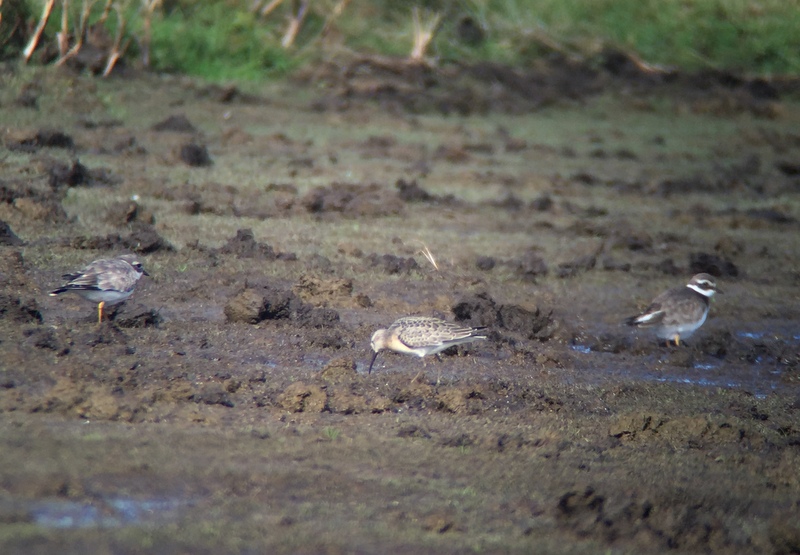 Curlew Sandpiper – with two Ringed Plovers
Curlew Sandpiper – with two Ringed Plovers
While we were standing there, we could hear a Bearded Tit calling. It seemed to be coming from back along the path, in the reeds along the ditch. Then the Bearded Tit flew over and landed just behind us, down in the reeds along the ditch the other side of the track. Even though it was out of view, we could hear it ‘pinging’, and occasionally see movement. We walked over to the edge of the ditch, peering over the top of the vegetation. Then more helpfully it climbed up into the tops of the reeds in full view just a few metres from us. It was a female – with no grey head, no black moustache. It perched up in full view for a minute or two, then the Bearded Tit flew off towards Salthouse. Great views!
 Bearded Tit – perched up in the tops of the reeds right next to us
Bearded Tit – perched up in the tops of the reeds right next to us
Walking back towards the road, we turned right onto Attenborough Walk and headed for Babcock Hide. On the way, we stopped to admire the Egyptian Geese on the grazing meadow. While we were standing there, a Wheatear appeared out on the grass, in amongst the cows.
The water levels at Babcock Hide have been rather static recently, which is not so good for waders, and the scrape looked fairly empty at first. There were a few ducks – Shelduck, Teal and Wigeon. There are cows grazing out here at the moment, and they kept walking back and forth in front of the hide. They mostly seemed to be very nervous of us, but it was quite a shock when one walked up and almost stuck its head through the flaps right in front of us, particularly as we were looking through binoculars at the time!
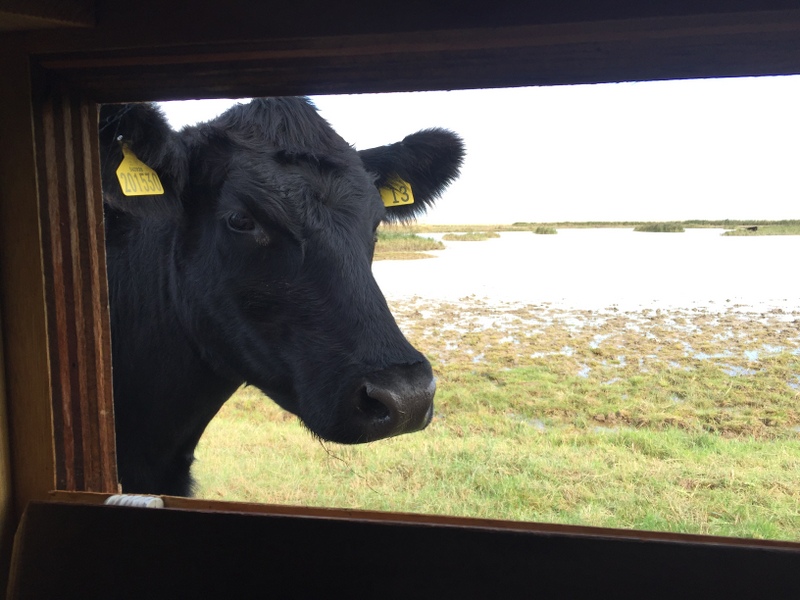 Cow – looking in on Babcock Hide
Cow – looking in on Babcock Hide
There were several Meadow Pipits and Pied Wagtails around the edges of the scrape. When a wagtail appeared right in front of the hide, we might have expected it to be another Pied, but it was very pale grey backed and also grey rumped. It was a White Wagtail, the continental race of Pied Wagtail, more commonly identified here in spring. Another migrant which had stopped off here on its way south.
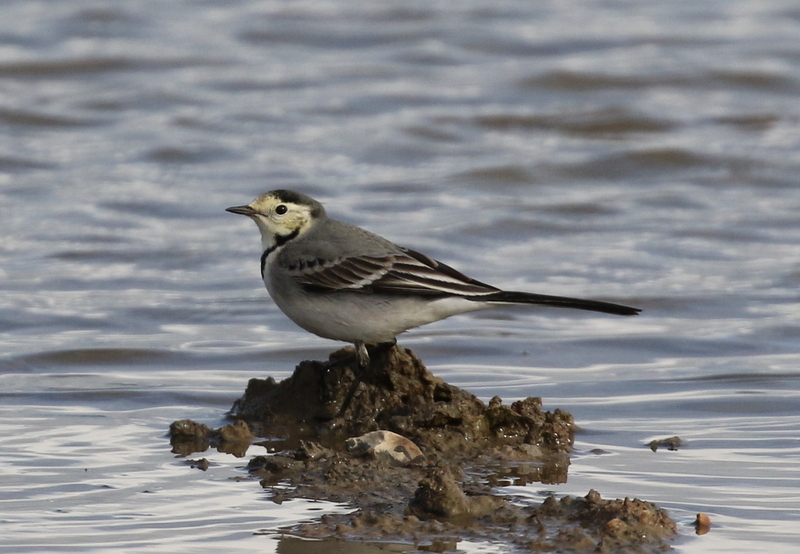 White Wagtail – in front of Babcock Hide
White Wagtail – in front of Babcock Hide
As the cows walked round in front of the hide, two Common Snipe came up from the grass round to our left and flew off over the back. Then a smaller snipe flew up from the reeds – another Jack Snipe. It flew back over the water, circled round a couple of times, before eventually dropping down again out of view at the back of the scrape. There are obviously a lot of Jack Snipe arriving at the moment for the winter – the number we have seen in the past three days is unusual.
With more shower clouds out over the sea and heading our way, we decided to spend the latter part of the afternoon at Holkham, where we had some more hides for shelter if necessary. We walked west from Lady Anne’s Drive, on the inland side of the pines. There were lots of Goldcrests in the trees and we heard a Yellow-browed Warbler calling. We had a quick look for it, but we were looking into the sun, and it seemed to move through very quickly. It stopped calling, and we couldn’t see any movement.
 Goldcrest – showing very well at Holkham
Goldcrest – showing very well at Holkham
A quick scan of Salts Hole produced three Little Grebes. We stopped again at the gate before Washington Hide. There were four Curlews in the field – hard to see until they put their heads up – and several Jays kept dropping down into the grass. A couple of Coal Tits chased each other round the pine above us. Then we saw black clouds coming and made a quick dash for the hide.
We got to Washington Hide just in time, and took shelter from the rain. Thankfully it passed through very quickly. We just had time to admire a few Gadwall in with the Mallard on the pool. There were several Song Thrushes and Redwings in the bushes. A Common Buzzard perched up in a tree. We had hoped we might be able to find a few Pink-footed Geese out on the grazing marshes. Although we saw a lot, they were flying up from behind the trees and heading off east.
When the rain stopped, we had a quick walk out onto the boardwalk, to pay homage to the sea. On the way, an exhausted Chiffchaff was flitting around on the ground below us.
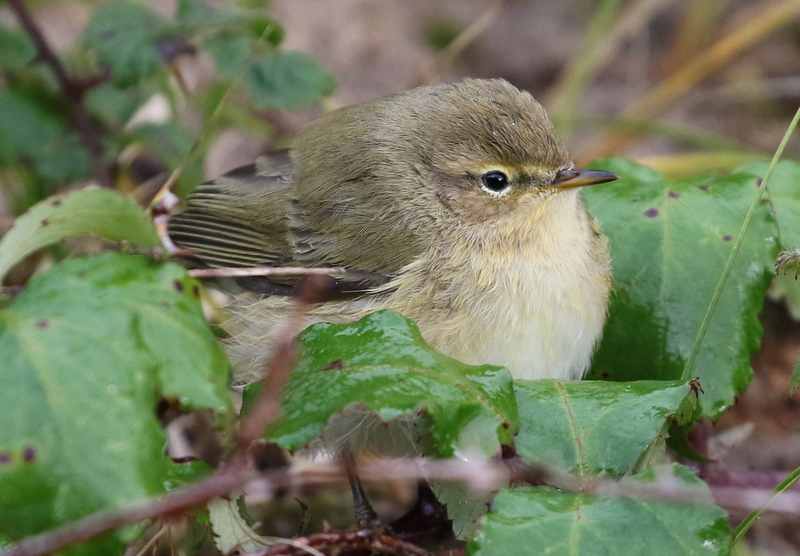 Chiffchaff – exhausted and feeding on the ground behind Washington Hide
Chiffchaff – exhausted and feeding on the ground behind Washington Hide
Carrying on west, we made our way along to Joe Jordan Hide. There were several Marsh Harriers flying in and out of the trees and hedges here. A Common Buzzard perched on a post in front of us. Scanning the grass, we found a single Pink-footed Geese on its own. Through the scope we could see that it was an injured bird, with one wing hanging down. That probably explains why it was here, rather than out on the saltmarsh.
Then it was time to walk back. We were almost back to Lady Anne’s Drive, when a Pied Flycatcher flew up from a puddle on the edge of the path. Unfortunately it disappeared into the trees before we could get a good look and wasn’t going to show itself again. Another Yellow-browed calling was some consolation. Then it was time to head for home. We rain clouds all around us, there were some stunning rainbows to admire.
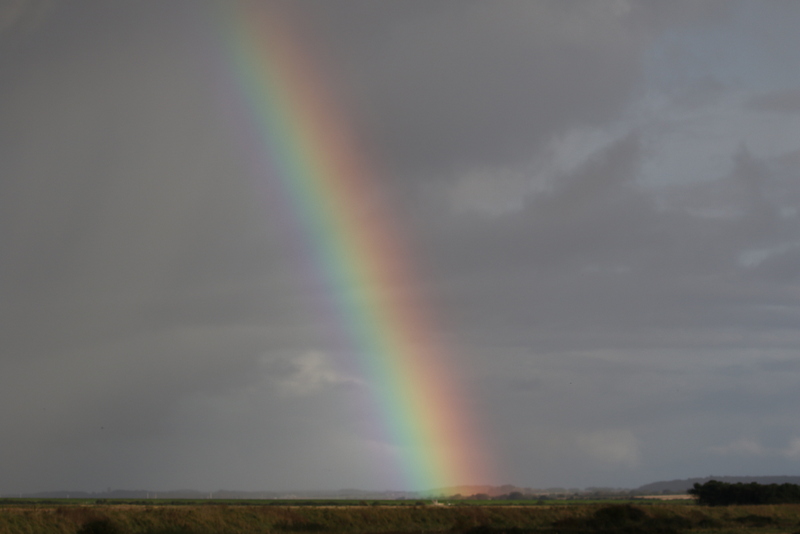 Rainbow – Holkham
Rainbow – Holkham
















